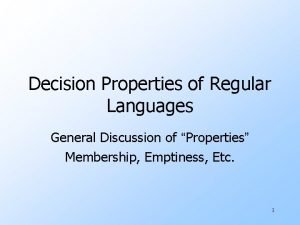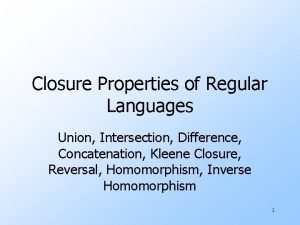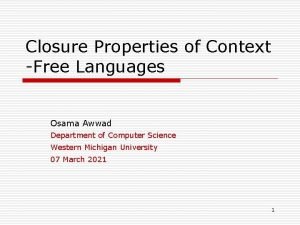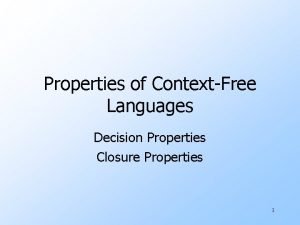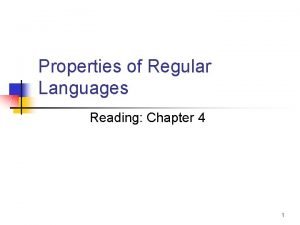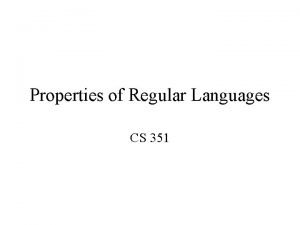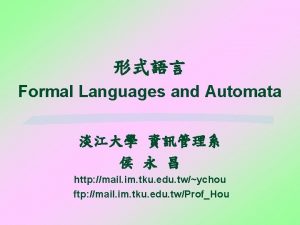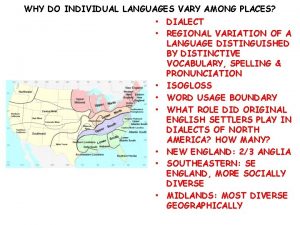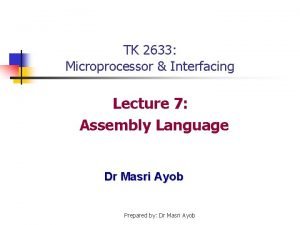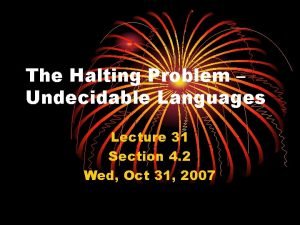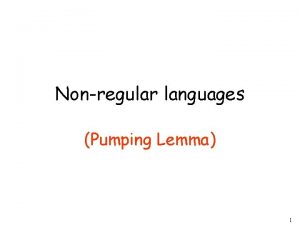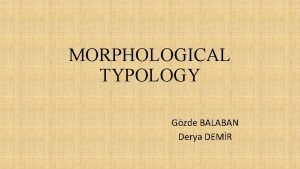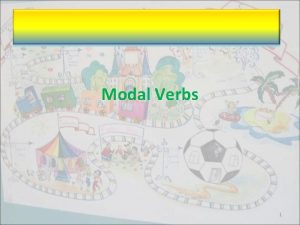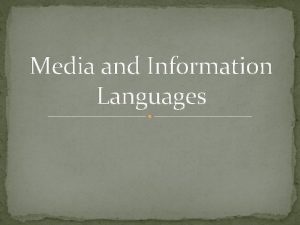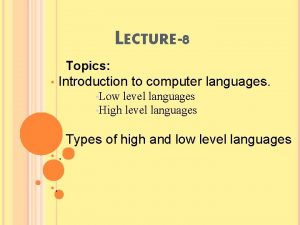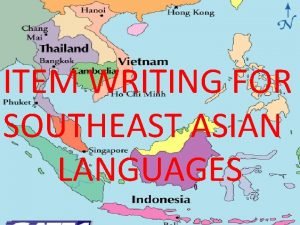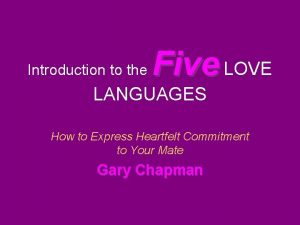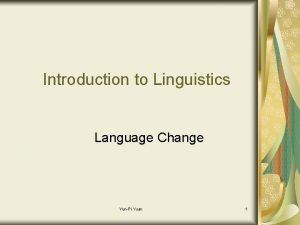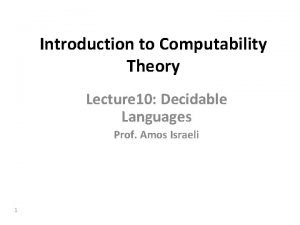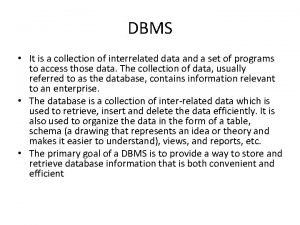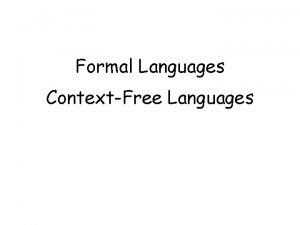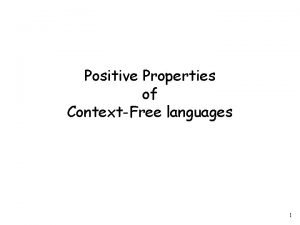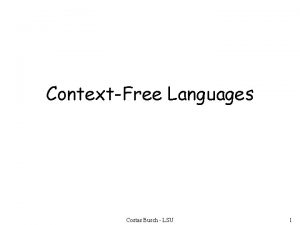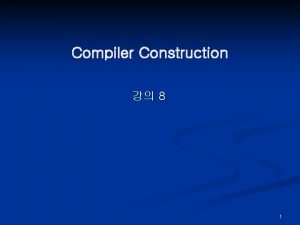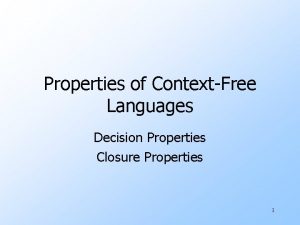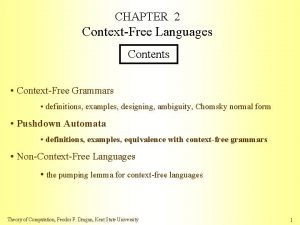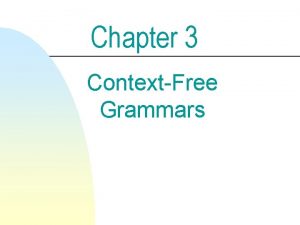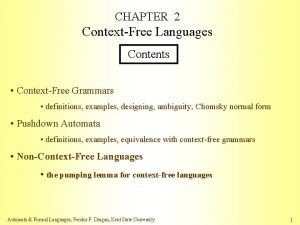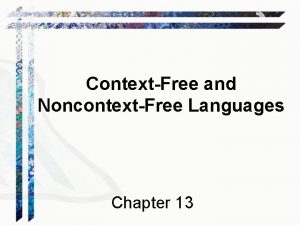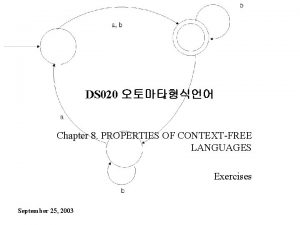Properties of Contextfree Languages Reading Chapter 7 1






























































- Slides: 62

Properties of Context-free Languages Reading: Chapter 7 1

Topics 1) 2) 3) Simplifying CFGs, Normal forms Pumping lemma for CFLs Closure and decision properties of CFLs 2

How to “simplify” CFGs? 3

Three ways to simplify/clean a CFG (clean) 1. Eliminate useless symbols (simplify) 2. Eliminate -productions 3. Eliminate unit productions A => B 4

Eliminating useless symbols Grammar cleanup 5

Eliminating useless symbols A symbol X is reachable if there exists: n S * X A symbol X is generating if there exists: n X * w, n for some w T* For a symbol X to be “useful”, it has to be both reachable and generating n S * X * w’, reachable for some w’ T* generating 6

Algorithm to detect useless symbols 1. 2. First, eliminate all symbols that are not generating Next, eliminate all symbols that are not reachable Is the order of these steps important, or can we switch? 7

Example: Useless symbols n n 1. 2. 3. S AB | a A b A, S are generating B is not generating (and therefore B is useless) ==> Eliminating B… (i. e. , remove all productions that involve B) 1. 2. 4. 5. S a A b Now, A is not reachable and therefore is useless Simplified G: What would happen if you reverse the order: 1. S a i. e. , test reachability before generating? Will fail to remove: A b 8

X * w Algorithm to find all generating symbols n n Given: G=(V, T, P, S) Basis: n n Every symbol in T is obviously generating. Induction: n n Suppose for a production A , where is generating Then, A is also generating 9

S * X Algorithm to find all reachable symbols n n Given: G=(V, T, P, S) Basis: n n S is obviously reachable (from itself) Induction: n n Suppose for a production A 1 2… k, where A is reachable Then, all symbols on the right hand side, { 1, 2 , … k} are also reachable. 10

Eliminating -productions A => 11

What’s the point of removing -productions? A Eliminating -productions Caveat: It is not possible to eliminate -productions for languages which include in their word set So we will target the grammar for the rest of the language Theorem: If G=(V, T, P, S) is a CFG for a language L, then L { } has a CFG without -productions Definition: A is “nullable” if A * n If A is nullable, then any production of the form “B CAD” can be simulated by: n B CD | CAD n This can allow us to remove transitions for A 12

Algorithm to detect all nullable variables n Basis: n n If A is a production in G, then A is nullable (note: A can still have other productions) Induction: n If there is a production B C 1 C 2…Ck, where every Ci is nullable, then B is also nullable 13

Eliminating -productions Given: G=(V, T, P, S) Algorithm: Detect all nullable variables in G Then construct G 1=(V, T, P 1, S) as follows: 1. 2. i. ii. For each production of the form: A X 1 X 2…Xk, where k≥ 1, suppose m out of the k Xi’s are nullable symbols Then G 1 will have 2 m versions for this production i. iii. i. e, all combinations where each Xi is either present or absent Alternatively, if a production is of the form: A , then remove it 14

Example: Eliminating productions n i. iii. Let L be the language represented by the following CFG G: S AB A a. AA | Simplified B b. BB | grammar Goal: To construct G 1, which is the grammar for L-{ } Nullable symbols: n n n {A, B} G 1 can be constructed from G as follows: B b | b. BB n ==> B b | b. BB Similarly, A a | a. AA Similarly, S A | B | AB Note: L(G) = L(G 1) U { } G 1: • S A | B | AB • A a | a. AA • B b | b. BB + • S 15

Eliminating unit productions A => B What’s the point of removing unit transitions ? E. g. , A=>B | … B=>C | … C=>D | … D=>xxx | yyy | zzz before B has to be a variable Will save #substitutions A=>xxx | yyy | zzz | … B=> xxx | yyy | zzz | … C=> xxx | yyy | zzz | … D=>xxx | yyy | zzz after 16

A B Eliminating unit productions Unit production is one which is of the form A B, where both A & B are variables E. g. , n n 1. 2. 3. 4. E T | E+T T F | T*F F I | (E) I a | b | Ia | Ib | I 0 | I 1 How to eliminate unit productions? n n Replace E T with E F | T*F n Then, upon recursive application wherever there is a unit production: n n n E F | T*F | E+T E I | (E) | T*F| E+T E a | b | Ia | Ib | I 0 | I 1 | (E) | T*F | E+T Now, E has no unit productions (substituting for T) (substituting for F) (substituting for I) Similarly, eliminate for the remainder of the unit productions 17

The Unit Pair Algorithm: to remove unit productions n n Suppose A B 1 B 2 … Bn Action: Replace all intermediate productions to produce directly n i. e. , A ; B 1 ; … Bn ; Definition: (A, B) to be a “unit pair” if A *B n We can find all unit pairs inductively: n n Basis: Every pair (A, A) is a unit pair (by definition). Similarly, if A B is a production, then (A, B) is a unit pair. Induction: If (A, B) and (B, C) are unit pairs, and A C is also a unit pair. 18

The Unit Pair Algorithm: to remove unit productions Input: G=(V, T, P, S) Goal: to build G 1=(V, T, P 1, S) devoid of unit productions Algorithm: 1. 2. Find all unit pairs in G For each unit pair (A, B) in G: 1. 2. Add to P 1 a new production A , for every B which is a non-unit production If a resulting production is already there in P, then there is no need to add it. 19

Example: eliminating unit productions G: 1. 2. 3. 4. G 1: 1. 2. 3. 4. E T | E+T T F | T*F F I | (E) I a | b | Ia | Ib | I 0 | I 1 E E+T | T*F | (E) | a| b | Ia | Ib | I 0 | I 1 T T*F | (E) | a| b | Ia | Ib | I 0 | I 1 F (E) | a| b | Ia | Ib | I 0 | I 1 I a | b | Ia | Ib | I 0 | I 1 Unit pairs Only non-unit productions to be added to P 1 (E, E) E E+T (E, T) E T*F (E, F) E (E) (E, I) E a|b|Ia | Ib | I 0 | I 1 (T, T) T T*F (T, F) T (E) (T, I) T a|b| Ia | Ib | I 0 | I 1 (F, F) F (E) (F, I) F a| b| Ia | Ib | I 0 | I 1 (I, I) I a| b | Ia | Ib | I 0 | I 1 20

Putting all this together… Theorem: If G is a CFG for a language that contains at least one string other than , then there is another CFG G 1, such that L(G 1)=L(G) - , and G 1 has: n n no -productions no unit productions no useless symbols Algorithm: Step 1) Step 2) Step 3) eliminate -productions eliminate unit productions eliminate useless symbols Again, the order is important! Why? 21

Normal Forms 22

Why normal forms? If all productions of the grammar could be expressed in the same form(s), then: n a. b. It becomes easy to design algorithms that use the grammar It becomes easy to show proofs and properties 23

Chomsky Normal Form (CNF) Let G be a CFG for some L-{ } Definition: G is said to be in Chomsky Normal Form if all its productions are in one of the following two forms: i. ii. n n n A BC A a where A, B, C are variables, or where a is a terminal G has no useless symbols G has no unit productions G has no -productions 24

CNF checklist Is this grammar in CNF? G 1: 1. 2. 3. 4. E E+T | T*F | (E) | Ia | Ib | I 0 | I 1 T T*F | (E) | Ia | Ib | I 0 | I 1 F (E) | Ia | Ib | I 0 | I 1 I a | b | Ia | Ib | I 0 | I 1 Checklist: • G has no -productions • G has no unit productions • G has no useless symbols • But… • the normal form for productions is violated So, the grammar is not in CNF 25

How to convert a G into CNF? n Assumption: G has no -productions, unit productions or useless symbols 1) For every terminal a that appears in the body of a production: create a unique variable, say Xa, with a production Xa a, and replace all other instances of a in G by Xa i. ii. Now, all productions will be in one of the following two forms: 2) n A B 1 B 2… Bk (k≥ 3) or A a Replace each production of the form A B 1 B 2 B 3… Bk by: 3) B 1 n A B 1 C 1 B 2 C 2 … Ck-3 Bk-2 Ck-2 B 2 C 2 and so on… C 1 Ck-2 Bk-1 Bk 26

Example #1 G in CNF: G: S => AS | BABC A => A 1 | 01 B => 0 B | 0 C => 1 C | 1 X 0 => 0 X 1 => 1 S => AS | BY 1 => AY 2 => BC A => AX 1 | X 0 Y 3 | X 0 X 1 Y 3 => AX 1 B => X 0 B | 0 C => X 1 C | 1 All productions are of the form: A=>BC or A=>a 27

Example #2 G: 1. 2. 3. 4. E E+T | T*F | (E) | Ia | Ib | I 0 | I 1 T T*F | (E) | Ia | Ib | I 0 | I 1 F (E) | Ia | Ib | I 0 | I 1 I a | b | Ia | Ib | I 0 | I 1 Step (1) e St 1. 2. 3. 4. 5. 6. p (2 ) 1. 2. 3. 4. 5. 6. 7. 8. 9. E EX+T | TX*F | X(EX) | IXa | IXb | IX 0 | IX 1 T TX*F | X(EX) | IXa | IXb | IX 0 | IX 1 F X(EX) | IXa | IXb | IX 0 | IX 1 I Xa | Xb | IXa | IXb | IX 0 | IX 1 X+ + X* * X+ + X( ( ……. E EC 1 | TC 2 | X(C 3 | IXa | IXb | IX 0 | IX 1 C 1 X+T C 2 X *F C 3 EX) T . . ……. …. 28

Languages with n For languages that include , n n Write down the rest of grammar in CNF Then add production “S => ” at the end E. g. , consider: G: S => AS | BABC A => A 1 | 01 | B => 0 B | 0 | C => 1 C | 1 | G in CNF: X 0 => 0 X 1 => 1 S => AS | BY 1 | Y 1 => AY 2 => BC A => AX 1 | X 0 Y 3 | X 0 X 1 Y 3 => AX 1 B => X 0 B | 0 C => X 1 C | 1 29

Other Normal Forms n Griebach Normal Form (GNF) n All productions of the form A==>a 30

Return of the Pumping Lemma !! Think of languages that cannot be CFL == think of languages for which a stack will not be enough e. g. , the language of strings of the form ww 31

Why pumping lemma? n A result that will be useful in proving languages that are not CFLs n n (just like we did for regular languages) But before we prove the pumping lemma for CFLs …. n Let us first prove an important property about parse trees 32

Observe that any parse tree generated by a CNF will be a binary tree, where all internal nodes have exactly two children (except those nodes connected to the leaves). The “parse tree theorem” Parse tree for w Given: n n Suppose we have a parse tree for a string w, according to a CNF grammar, G=(V, T, P, S) Let h be the height of the parse tree S = A 0 A 1 A 2 . . . |w| ≤ 2 h-1 In other words, a CNF parse tree’s string yield (w) can no longer be 2 h-1 = tree height Ah-1 Implies: n h a w 33

To show: |w| ≤ 2 h-1 Proof…The size of parse trees Proof: (using induction on h) Basis: h = 1 Parse tree for w Derivation will have to be “S a” |w|= 1 = 21 -1. Ind. Hyp: h = k-1 S = A 0 A B |w|≤ 2 k-2 h = height Ind. Step: h = k S will have exactly two children: S AB Heights of A & B subtrees are at most h-1 w = w. A w. B, where |w. A| ≤ 2 k-2 and |w. B| ≤ 2 k-2 |w| ≤ 2 k-1 w. B w. A w 34

Implication of the Parse Tree Theorem (assuming CNF) Fact: n If the height of a parse tree is h, then n ==> |w| ≤ 2 h-1 Implication: n If |w| ≥ 2 m, then n Its parse tree’s height is at least m+1 35

The Pumping Lemma for CFLs Let L be a CFL. Then there exists a constant N, s. t. , n if z L s. t. |z|≥N, then we can write z=uvwxy, such that: 1. 2. 3. |vwx| ≤ N vx≠ For all k≥ 0: uvkwxky L Note: we are pumping in two places (v & x) 36

Proof: Pumping Lemma for CFL n n If L=Φ or contains only , then the lemma is trivially satisfied (as it cannot be violated) For any other L which is a CFL: n n Let G be a CNF grammar for L Let m = number of variables in G Choose N=2 m. Pick any z L s. t. |z|≥ N the parse tree for z should have a height ≥ m+1 (by the parse tree theorem) 37

Meaning: Repetition in the last m+1 variables Parse tree for z h-m≤ i < j ≤ h S = A 0 , > m levels A 1 m variables S = A 0 + Ai = A j A 2 Ai . . . h ≥ m+1 Aj m+1 Ah-1 u v Ah=a x y w z = uvwxy z • Therefore, vx≠ 38

Extending the parse tree… S = A 0 Replacing Aj with Ai (k times) Or, replacing Ai with Aj Ai=Aj Aj h ≥ m+1 Ai … v … Ai u v w x u y z = uwy x w z = uvkwxky y ==> For all k≥ 0: uvkwxky L 39

Proof contd. . • Also, since Ai’s subtree no taller than m+1 ==> the string generated under Ai‘s subtree, which is vwx, cannot be longer than 2 m (=N) But, 2 m =N ==> |vwx| ≤ N This completes the proof for the pumping lemma. 40

Application of Pumping Lemma for CFLs Example 1: L = {ambmcm | m>0 } Claim: L is not a CFL Proof: n n n Let N <== P/L constant Pick z = a. Nb. Nc. N Apply pumping lemma to z and show that there exists at least one other string constructed from z (obtained by pumping up or down) that is L 41

Proof contd… n n z = uvwxy As z = a. Nb. Nc. N and |vwx| ≤ N and vx≠ n n ==> v, x cannot contain all three symbols (a, b, c) ==> we can pump up or pump down to build another string which is L 42

Example #2 for P/L application n L = { ww | w is in {0, 1}*} n Show that L is not a CFL n Try string z = 0 N 0 N n n what happens? Try string z = 0 N 1 N n what happens? 43

Example 3 n n L={ 2 k 0 | k is any integer) Prove L is not a CFL using Pumping Lemma 44

Example 4 n L = {aibjck | i<j<k } n Prove that L is not a CFL 45

CFL Closure Properties 46

Closure Property Results n CFLs are closed under: n n n n Union Concatenation Kleene closure operator Substitution Homomorphism, inverse homomorphism reversal CFLs are not closed under: n n n Intersection Difference Complementation Note: Reg languages are closed under these operators 47

Strategy for Closure Property Proofs n First prove “closure under substitution” Using the above result, prove other closure properties n CFLs are closed under: n n Prove this first n n n Union Concatenation Kleene closure operator Substitution Homomorphism, inverse homomorphism Reversal 48

Note: s(L) can use a different alphabet The Substitution operation For each a ∑, then let s(a) be a language If w=a 1 a 2…an L, then: n s(w) = { x 1 x 2 … } s(L), s. t. , xi s(ai) Example: n n n Let ∑={0, 1} Let: s(0) = {anbn | n ≥ 1}, s(1) = {aa, bb} If w=01, s(w)=s(0). s(1) n E. g. , s(w) contains a 1 b 1 aa, a 1 b 1 bb, a 2 b 2 aa, a 2 b 2 bb, … and so on. 49

CFLs are closed under Substitution IF L is a CFL and a substititution defined on L, s(L), is s. t. , s(a) is a CFL for every symbol a, THEN: n s(L) is also a CFL What is s(L)? L w 1 w 2 w 3 w 4 … s(L) s(w 1) s(w 2) s(w 3) s(w 4) … Note: each s(w) is itself a set of strings 50

CFLs are closed under Substitution n n G=(V, T, P, S) : CFG for L Because every s(a) is a CFL, there is a CFG for each s(a) n n n Let Ga = (Va, Ta, Pa, Sa) Construct G’=(V’, T’, P’, S) for s(L) P’ consists of: n n The productions of P, but with every occurrence of terminal “a” in their bodies replaced by Sa. All productions in any Pa, for any a ∑ Parse tree for G’: Sa 1 S Sa n Sa 2 … x 1 x 2 xn 51

Substitution of a CFL: example n n Let L = language of binary palindromes s. t. , substitutions for 0 and 1 are defined as follows: n s(0) = {anbn | n ≥ 1}, s(1) = {xx, yy} Prove that s(L) is also a CFL. CFG for L: CFG for s(0): CFG for s(1): S=> 0 S 0|1 S 1| S 0=> a. S 0 b | ab S 1=> xx | yy Therefore, CFG for s(L): S=> S 0 SS 0 | S 1 S S 1 | S 0=> a. S 0 b | ab S 1=> xx | yy 52

CFLs are closed under union Let L 1 and L 2 be CFLs To show: L 2 U L 2 is also a CFL Let us show by using the result of Substitution n Make a new language: n Lnew = {a, b} s. t. , s(a) = L 1 and s(b) = L 2 ==> s(Lnew) == same as == L 1 U L 2 n A more direct, alternative proof n Let S 1 and S 2 be the starting variables of the grammars for L 1 and L 2 n Then, Snew => S 1 | S 2 53

CFLs are closed under concatenation n Let L 1 and L 2 be CFLs Let us show by using the result of Substitution n Make Lnew= {ab} s. t. , s(a) = L 1 and s(b)= L 2 ==> L 1 L 2 = s(Lnew) n A proof without using substitution? 54

CFLs are closed under Kleene Closure n Let L be a CFL n Let Lnew = {a}* and s(a) = L 1 n Then, L* = s(Lnew) 55

We won’t use substitution to prove this result CFLs are closed under Reversal n n Let L be a CFL, with grammar G=(V, T, P, S) For LR, construct GR=(V, T, PR, S) s. t. , n If A==> is in P, then: n A==> R is in PR n (that is, reverse every production) 56

Some negative closure results CFLs are not closed under Intersection n Existential proof: n n n Both L 1 and L 2 are CFLs n n n Grammars? But L 1 L 2 cannot be a CFL n n L 1 = {0 n 1 n 2 i | n≥ 1, i≥ 1} L 2 = {0 i 1 n 2 n | n≥ 1, i≥ 1} Why? We have an example, where intersection is not closed. Therefore, CFLs are not closed under intersection 57

Some negative closure results CFLs are not closed under complementation n n Follows from the fact that CFLs are not closed under intersection L 1 L 2 = L 1 U L 2 Logic: if CFLs were to be closed under complementation the whole right hand side becomes a CFL (because CFL is closed for union) the left hand side (intersection) is also a CFL but we just showed CFLs are NOT closed under intersection! CFLs cannot be closed under complementation. 58

Some negative closure results CFLs are not closed under difference n n Follows from the fact that CFLs are not closed under complementation Because, if CFLs are closed under difference, then: n n n L = ∑* - L So L has to be a CFL too Contradiction 59

Decision Properties n Emptiness test n n n Generating test Reachability test Membership test n PDA acceptance 60

“Undecidable” problems for CFL n n n Is a given CFG G ambiguous? Is a given CFL inherently ambiguous? Is the intersection of two CFLs empty? Are two CFLs the same? Is a given L(G) equal to ∑*? 61

Summary Normal Forms n n Chomsky Normal Form Griebach Normal Form Useful in proroving P/L Pumping Lemma for CFLs n n Main difference: z=uviwxiy Closure properties n n n Closed under: union, concatentation, reversal, Kleen closure, homomorphism, substitution Not closed under: intersection, complementation, difference 62
 While reading activities
While reading activities Decision properties of regular languages
Decision properties of regular languages Decision properties of regular language
Decision properties of regular language Regular languages closure properties
Regular languages closure properties Closure and decision properties of context free languages
Closure and decision properties of context free languages Decision properties of cfl
Decision properties of cfl Closure and decision properties of context free languages
Closure and decision properties of context free languages Decision properties of context free languages
Decision properties of context free languages Decision properties of regular languages
Decision properties of regular languages Decision properties of regular languages
Decision properties of regular languages Properties of regular languages
Properties of regular languages Right linear grammar
Right linear grammar Extensive vs intensive
Extensive vs intensive Is smell a physical property
Is smell a physical property St. louis
St. louis Difference between silent reading and reading aloud
Difference between silent reading and reading aloud Types of reading skill
Types of reading skill What is shared reading
What is shared reading Ordinary reading vs critical reading
Ordinary reading vs critical reading Intensive reading and extensive reading
Intensive reading and extensive reading Intensive and extensive reading
Intensive and extensive reading Intensive reading definition
Intensive reading definition Why do individual languages vary among places?
Why do individual languages vary among places? Assembly language list
Assembly language list Jumlah level dalam gambar ini adalah . . . .
Jumlah level dalam gambar ini adalah . . . . Turing unrecognizable languages
Turing unrecognizable languages Love language results
Love language results 5 love languages test
5 love languages test Love languages adults
Love languages adults What is love language meaning
What is love language meaning 11 official languages of south africa
11 official languages of south africa How many languages are there
How many languages are there Ror programming language
Ror programming language Roman achievements that are still used today
Roman achievements that are still used today Relational query languages in dbms
Relational query languages in dbms Real-time systems and programming languages
Real-time systems and programming languages Language
Language Cs 421 uiuc
Cs 421 uiuc Real time example of multithreading in java
Real time example of multithreading in java Pumping lemma non regular languages examples
Pumping lemma non regular languages examples Akwa ibom language
Akwa ibom language New zealand official languages english
New zealand official languages english Flexive languages
Flexive languages Modern languages for life and work
Modern languages for life and work Carol can speak three foreign languages
Carol can speak three foreign languages Importance of media and information languages
Importance of media and information languages Love language questions
Love language questions Low level languages
Low level languages Asian languages written
Asian languages written Five love languages.com
Five love languages.com Programming languages levels
Programming languages levels Introduction to programming languages
Introduction to programming languages Polysynthetic language
Polysynthetic language Decidable languages
Decidable languages History of computer languages
History of computer languages Front end of a compiler
Front end of a compiler Plc coding language
Plc coding language Minority dialect definition
Minority dialect definition Latin and romance languages
Latin and romance languages Euphemism etymology
Euphemism etymology Adf school of languages
Adf school of languages Defence centre for languages and culture
Defence centre for languages and culture A collection of interrelated data files or tables
A collection of interrelated data files or tables

